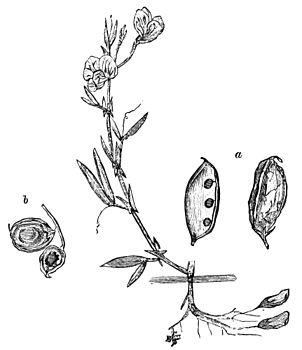I have already alluded to our cardamines, the pods of which open elastically and throw their seed some distance. A Brazilian species, C. chenopodifolia (Fig. 17), besides the usual long pods (Fig. 17, a a), produces also short, pointed ones (Fig. 17, b b), which it buries in the ground.
Arachis hypogœa is the ground-nut of the West Indies. The flower is yellow and resembles that of a pea, but has an elongated calyx, at the base of which, close to the stem, is the ovary. After the flower has faded, the young pod, which is oval, pointed, and very minute, is carried forward by the growth of the stalk, which becomes two or three inches long and curves downward, so as generally to force the pod into the ground. If it fails in this, the pod does not develop, but soon perishes; on the other hand, as soon as it is underground, the pod begins to grow and develops two large seeds.
In Vicia amphicarpa (Fig. 18), a south European species of vetch.

Fig. 19.—Lathyrus amphicarpos. (After Sowerby.) a, ordinary pods; b, subterranean pods.
there are two kinds of pods. One of the ordinary form and habit (a), the other (b) oval, pale, containing only two seeds, borne on underground stems, and produced by flowers which have no corolla.
